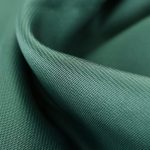When you're considering acid washing, the choice of fabric can significantly impact the final look and feel of your garments. You might find that cotton denim stands out for its ability to absorb treatments effectively, creating unique textures. However, cotton-polyester blends offer their own durability advantages, while ramie and linen bring interesting characteristics to the mix as well. Each fabric has its strengths, and understanding these can make a big difference in your projects. So, which fabric will best suit your vision and why does that matter?
Table of Contents
Key Takeaways
- Cotton Denim is ideal for acid washing due to its effective chemical interaction and ability to create unique textures and fades.
- Cotton-Polyester Blends maintain shape and resist wrinkling, making them durable while keeping acid wash designs vibrant.
- Ramie Fabric offers strength and natural luster, achieving distinct faded looks while being environmentally sustainable.
- Linen is breathable and absorbs dyes beautifully, enhancing comfort and providing a relaxed, lived-in feel post-washing.
Cotton Denim
Cotton denim is the ideal fabric for acid washing because it absorbs the treatment well, creating unique textures and fades. When you choose 100% cotton denim, you're ensuring the fabric interacts effectively with the chemicals used in the process. This interaction allows for varied, eye-catching results that enhance your denim pieces.
As you work with cotton denim, you'll notice how it takes on the acid wash in distinctive ways. The fibers swell and soften, making it easier to achieve that vintage, worn-in look. Plus, the natural color of cotton allows for better contrast between the lighter and darker areas created during washing.
One of the best aspects of cotton denim is its versatility. Whether you're working with a classic blue jean jacket or trendy high-waisted shorts, the fabric adapts beautifully. You can experiment with different techniques, like splattering or dipping, to create your unique style.
Cotton-Polyester Blends
When you consider cotton-polyester blends for acid washing, you're choosing a fabric that combines the best of both worlds—durability and softness. These blends typically feature around 60% cotton and 40% polyester, giving you the breathability of cotton while enhancing the material's strength and longevity. This makes them a fantastic option for acid washing, as they hold up well against the harsh chemicals involved.
You'll appreciate how cotton-polyester blends maintain their shape and resist wrinkling, ensuring your acid-washed garments look fresh longer. They also dry quicker than pure cotton, which can be a real benefit in both production and everyday wear. Additionally, these blends are less prone to fading, so your vibrant acid wash designs will stay eye-catching and lively.
When you're looking for versatility, cotton-polyester blends can easily transition from casual to semi-formal settings. Plus, they often come at a more affordable price point than 100% cotton fabric, making them a budget-friendly option.
In short, if you want a fabric that's resilient, stylish, and easy to care for, cotton-polyester blends are undoubtedly worth considering for your acid-washing projects.
Ramie Fabric
Ramie fabric offers a unique blend of strength and natural luster, making it an excellent choice for acid washing projects. This fabric is derived from the ramie plant and is known for its durability and resistance to wrinkles.
When you work with ramie, you'll notice how well it holds up during the acid washing process, allowing you to achieve a distinct faded look without compromising the fabric's integrity.
Here are three key benefits of using ramie fabric for your acid washing:
- Durability: Ramie is one of the strongest natural fibers, ensuring your pieces can withstand rigorous treatment while maintaining their shape and structure.
- Natural Luster: The inherent sheen of ramie adds an appealing visual element to your final product, making it stand out in any wardrobe.
- Eco-Friendly: Since ramie is a plant-based fiber, it's more sustainable compared to synthetic alternatives, allowing you to make environmentally conscious choices.
Linen Options
Linen offers a breathable and textured option for acid washing, enhancing both comfort and style in your projects. When you choose linen, you're opting for a fabric that not only looks great but also performs well under the acid washing process. Its natural fibers absorb dyes beautifully, allowing you to achieve vibrant and unique effects.
One of the standout features of linen is its durability. Unlike some softer fabrics, linen holds up well under the rigors of acid washing, ensuring your creations last. Plus, its natural resistance to mildew and mold means you won't have to worry about wear and tear as much.
You'll also appreciate how linen softens with each wash, giving your pieces a relaxed, lived-in feel that's perfect for casual styles. Keep in mind that the texture of linen can vary; you might find options that are more coarse or smoother, depending on your desired aesthetic.
Incorporating linen into your acid washing projects can elevate your designs while providing functionality. Whether you're crafting garments or home textiles, linen's unique qualities make it an excellent choice for your next creative endeavor.
Specialty Synthetic Fabrics
Specialty synthetic fabrics can offer unique benefits for acid washing, providing versatility and durability that natural fibers sometimes lack.
These materials not only withstand harsh chemicals better, but they also maintain their shape and color over time.
When you're considering synthetic options, here are three standout choices:
- Polyester: Known for its strength, polyester can handle the rigors of acid washing without breaking down. Its quick-drying properties also make it a favorite for those who want a faster turnaround.
- Nylon: This fabric is lightweight yet incredibly durable. Nylon's resistance to abrasion helps it stand up to the acid washing process while retaining its structure, so your garments look great longer.
- Spandex: Often blended with other fabrics, spandex offers incredible elasticity. This is perfect for fitted garments, ensuring that they move with you, even after multiple washes.
Frequently Asked Questions
Can Acid Washing Be Done on Knit Fabrics?
Yes, you can acid wash knit fabrics, but you should be cautious. The process might weaken the fibers, causing damage or distortion. Always test on a small area first to see how the fabric reacts.
How Often Should Acid Washed Fabrics Be Washed?
You should wash acid-washed fabrics after about every five wears, or sooner if they get stained. This helps maintain their unique look while preventing any buildup of dirt or odors that can develop over time.
What Safety Precautions Should Be Taken During Acid Washing?
When you're acid washing, always wear gloves and goggles to protect your skin and eyes. Work in a well-ventilated area, and keep a neutralizing solution nearby. It's crucial to follow safety guidelines diligently.
Can Acid Washing Damage Fabric Fibers Over Time?
Yes, acid washing can damage fabric fibers over time. If you're using harsh chemicals frequently, you'll notice the fibers weaken, lose elasticity, and may even fade, affecting the garment's overall appearance and durability.
Is Acid Washing Suitable for All Clothing Types?
Acid washing isn't suitable for all clothing types. You should avoid using it on delicate fabrics like silk or wool, as it can weaken fibers. Always test a small area first to ensure durability.
- The Ultimate Guide: How to Properly Wash Gore-Tex Gloves - July 1, 2025
- Is It Safe to Use OxiClean on Gore-Tex Jackets? - July 1, 2025
- Can You Use Non-Chlorine Bleach on Gore-Tex? A Safety Guide - July 1, 2025







